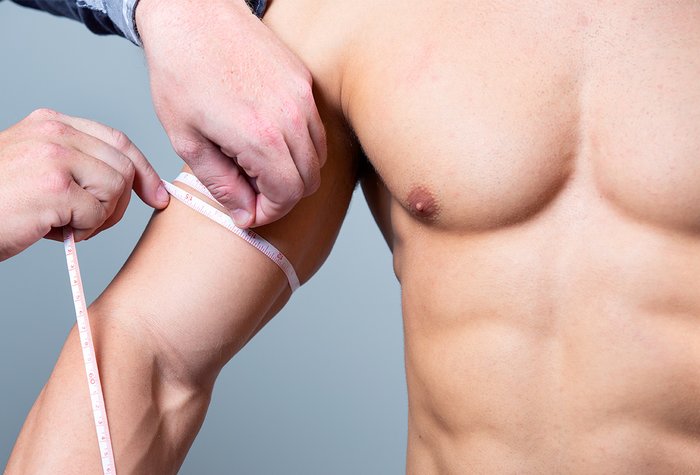Products You May Like
Recently, I didn’t eat any food for 60 hours. Like, in a row.
I know what you’re thinking. So much gains lost. Many catabolisms.
Years ago, I would have been right there with you. In fact, I used to call intermittent fasting “intermittent starving.” I thought it was the dumbest thing I’d ever heard of.
As I wrote in “How Social Media Killed the Bulk…and Your Gains,” I was from the old school of muscle building. That means eating every 2-3 hours. If I went longer than that without a tuna sandwich or a mass-blaster mega-millions shake that tasted how the drywall section of Home Depot smells, I was sure I’d waste away into the physique of a crisis actor.
Then I got older. And after hearing positive things, I spent some time really delving into the science and possible benefits of intermittent fasting in general, and longer faster protocols. What I found was a lot of potential upside for lifters—particularly aging lifters—and little to no downside.
Here’s why you shouldn’t fear the fast, and how I do it.
Fasting, Health, and Muscle
To be clear, there’s nothing directly anabolic about fasting. After all, cellular growth and muscle protein synthesis are both driven by a process known as the mTOR pathway, and it’s protein and weight training that get mTOR all hot and bothered. No nutrients, no mTOR. No mTOR, no growth.
But there’s a downside to that relationship, as well. Since mTOR drives cellular growth, it also has been linked in the long term to things like cancer cell growth and accelerated aging. I know we all love the gains, but dying in your 30s jacked, while looking like you were a hard 73, doesn’t sound appealing. I’m being sarcastic, but there’s more research and discussion than ever about mTOR, cancer, and aging—enough to get the attention of plenty of lifelong mTOR jockeys like me.
Now, mTOR isn’t bad. But ideally, we’d be able to turn it on selectively, then turn it off again, rather than just have it on all the time. Why? Because every physiological function has an antagonist to it in order to create balance, or physiological homeostasis. The off switch to mTOR is something called AMP-activated protein kinase, or AMPK, which helps to regulate cellular metabolism.
If an excess of nutrients drive mTOR, then an absence of nutrients seems to drive AMPK. And AMPK does some pretty sweet things once activated. It increases glucose uptake and fat oxidation, for one. This is likely one reason that fasting has been shown to promote lower blood glucose, and make you more insulin sensitive, thus the uptake of nutrients into the cells is vastly improved.[1] Over time, those are both benefits that can help you be leaner and more jacked, but also simply healthier.
But even cooler is that fasting turns on something called “autophagy.” Autophagy is the process in which healthy cells hunt out dead or diseased cells and recycle them into new and usable cellular parts.[2]
How significant are the effects of fasting on overall health? Pretty eye-opening, although there’s still plenty more research to give a full picture. Normally a loss in weight is required to see positive changes in the most important health markers. But with fasting, even when fat/weight loss hasn’t occurred, we see things like it supporting healthy blood pressure and a lowering of oxidative stress.[3]
But seriously: What about muscle loss? Well, it’s been studied. And as of yet, nobody has presented a well-designed study that shows any muscle loss resulting from fasting. On the other hand, in a meta-analysis done at Johns Hopkins, researchers found that fasting led to better muscle retention than traditional reduced-calorie dieting.[4]

And before you wheel out the old “Yeah, but the subjects were probably obese,” fit folk have also been shown to lose fat and gain muscle using eight-hour feeding windows.[5]
The upside for you? Honestly, knowing what we know right now, losing gains doesn’t seem to be a concern. The downside: If you were hoping to read this article and have me suggest not skipping some meals, sorry. It’s time to get hungry.
How (and Why) to Do a Longer Fast
With all those upsides in mind, I think fasting should be seen as a weapon in the muscle-building arsenal. It may not be anabolic on its own, but it’s something you can do to create a more muscle-friendly environment. Whether you use a daily 16:8 approach, alternate day fasting, or do a longer fast once a month, it’s something everyone who is serious about long-term health and wellness should be considering.
So why do a longer fast? For one, it makes smaller fasting protocols far more manageable on a day-to-day basis. And if there’s no risk of muscle loss, then what’s the downside?
“The hunger,” you reply. Oh, that. Well, I can help you there, too.
Because here’s the thing: I don’t believe you have to go full-on zero-calorie to consider it a fast, or to see the benefits of fasting. And I’m not alone. Many of the studies into what is known as “alternate day” fasting actually allow calories—but a small amount, like 25 percent of a normal day.[6] The popular 5:2 diet is also structured this way, with five full eating days and two very low-calorie days.
After experimenting with longer fasts, I’ve found that a small amount of strategic liquid nutrition can make a big difference in how pleasant and repeatable of an experience a fast is. That’s a big upside.
So, here’s how I do it. First of all, it’s not three continuous days of not eating. Really, it’s just a weekend. I eat on Friday, go to bed, then don’t eat on Saturday and Sunday. (In case you were wondering, I don’t eat while I’m sleeping. So, sleeping counts as part of the 60 hours. It’s really two full days of not eating, plus three nights.)
Day 1:
6 a.m. Wake up. Drink enough water to fill up a swimming pool made for Jabba the Hutt to do cannonballs in. Like, about half a gallon just to start the day. I also add some Himalayan sea salt for electrolytes.
8 a.m. Take a serving of exogenous ketones. Why? Well, one big thing the ketones have going for them is that they suppress the hormone ghrelin.[7] That’s the “hunger hormone” that tells your brain to shuttle sustenance down your gullet. Since you’re not eating, it’s pretty handy to not feel so ravenous. Ketones also cause a reduction in your body’s glucose usage, which could theoretically further help protect muscle protein from being converted into glucose for energy.[8]
8:30 a.m. Do steady state cardio for 30 minutes. I don’t weight train during the 60-hour fasting periods. Reason being, if there’s no protein coming in for the most part, that means there’s no way to offset muscle protein breakdown and damage that comes from lifting. So put your squats and deads on hold until you’re fed, and wait until Monday to start Jacked in 3.
That doesn’t mean you should disappear into the couch, though. I usually bang out two low-key steady-state sessions a day during the two whole days of fasting. I’m talking seriously low-key, like 30-45 minutes of walking. If you think you’re up for hardcore conditioning work while you’re fasting, you’re fooling yourself.
12:00 p.m. Bone Broth. Technically, bone broth has calories. There’s also maybe 10 grams of protein in a serving. If you’re some kind of fasting zealot you will say that it breaks a fast, but there’s lots of different kinds of fasts, done for lots of different reasons. One reason to use bone broth here is to ensure I’m getting enough electrolytes. As you might imagine, since I’m fasting for 60 hours, there are no carbohydrates coming in (did I mention I don’t eat anything during the 60 hours?), which means there will be a loss in water, as well. But it also tastes good and helps keep the beast under control.
3 p.m. Take ketones again. I’m still not hungry. I’m used to fasting for 16 hours a day, so the first day is always fairly easy for me.
4:30 – 6:30 p.m. Take an epic nap. This doesn’t always happen when I’m fasting, but when it does, I go with it.
7 p.m. More bone broth.I’m hungry now. This helps. It doesn’t help the way a slice of cheesecake helps, but it helps.
7:30 – 8:00 p.m. Take a walk.Normally I’d do this during the afternoon. But some days, it’s impossible because I’m watching the backs of my eyelids.
10 p.m. Go to sleep.

Day 2 looks essentially just like Day 1, from a supplement and schedule standpoint. Late afternoon on Day 2 is usually when I find hunger peaking, and I experience a weird dry-mouth thing that doesn’t go away no matter how much water I consume. The incredibly acidic taste in my mouth on Day 2 is also a telltale sign that I’m kicking into ketosis, a known side effect of longer fasts.
Because I am a Viking stud-muffin warrior, I can power on through Day 2 without caving to some delectable goodness in any fashion, hit the hay, and wake up on Monday…not wanting to eat.
Wait. What?
That’s right. Without fail, each time I’ve done a long fast I have less desire to eat on Monday than I did the previous two days of fasting. I also find my mental acuity tends to be off the charts at this point (although I know as soon as I eat, I’ll be back to just the normal me.)
My go-to meal in breaking the fast is usually some whole eggs, avocado, bacon, and some form of greens. That’s nothing but protein and fats for the most part, but I still feel a slight downshift in mental focus and clarity from it.
Then, after a meal, it’s back to normal life. Each time you do this, it gets more manageable. That doesn’t mean it’s ever entirely easy or pleasant, but it’s manageable. And yes, I’ve seen it make me and many other people leaner and more in control of their nutritional decisions—with no detractions from their jacktitude.
How to Get Started
I want to be clear, not eating for 60 hours is no bed of roses, especially if you haven’t been doing any form of fasting at all. I’ve done time restricted feeding for the better part of two years now, and fasting for 60 hours still has its moments of difficulty.
If you’re inclined to embark on such a fast, I’d suggest a few weeks of acclimating to fasting by having a few days a week where you fast for 16-18 hours, or fasting for 24 hours one day every other week before trying it.
Let me also add that fasting isn’t some magic pill for fat loss. Fat loss is primarily driven by creating an energy deficit, which can be done in a myriad of ways. That could be eating six times a day, two times a day, or 19 times a day, as long as you’re accounting for calories.
Fasting can make it easier to achieve an energy deficit simply because you’re restricting your feeding time during the day. But I can still easily overrun my caloric intake for the day in a single meal. I have to be aware of that even when using a time-restricted feeding approach.
Fasting also doesn’t negate the importance of eating high-quality foods during the time you do feed. A half-rack of cheap beer and a bag of Halloween candy is still garbage, no matter how long you’ve been fasting before having it. Your nutritional habits, regardless of whether you’re using a time-restricted eating approach or something more traditional, should always be grounded in consuming high-quality whole-food sources. And if you find yourself bingeing after fasting—which some people do—then it’s not for you.
Beyond that, if you’re curious, try it. The best part: You don’t have to do anything at all. Every once in a while, just stop eating.
References
- Halberg, N., Henriksen, M., Soderhamn, N., Stallknecht, B., Ploug, T., Schjerling, P., & Dela, F. (2005). Effect of intermittent fasting and refeeding on insulin action in healthy men. Journal of Applied Physiology, 99(6), 2128-2136.
- Alirezaei, M., Kemball, C. C., Flynn, C. T., Wood, M. R., Whitton, J. L., & Kiosses, W. B. (2010). Short-term fasting induces profound neuronal autophagy. Autophagy, 6(6), 702-710.
- Sutton, E. F., Beyl, R., Early, K. S., Cefalu, W. T., Ravussin, E., & Peterson, C. M. (2018). Early time-restricted feeding improves insulin sensitivity, blood pressure, and oxidative stress even without weight loss in men with prediabetes. Cell Metabolism, 27(6), 1212-1221
- Alhamdan, B. A., Garcia‐Alvarez, A., Alzahrnai, A. H., Karanxha, J., Stretchberry, D. R., Contrera, K. J., … & Cheskin, L. J. (2016). Alternate‐day versus daily energy restriction diets: which is more effective for weight loss? A systematic review and meta‐analysis. Obesity Science & Practice, 2(3), 293-302.
- Moro, T., Tinsley, G., Bianco, A., Marcolin, G., Pacelli, Q. F., Battaglia, G., … & Paoli, A. (2016). Effects of eight weeks of time-restricted feeding (16/8) on basal metabolism, maximal strength, body composition, inflammation, and cardiovascular risk factors in resistance-trained males. Journal of Translational Medicine, 14(1), 290.
- Varady, K. A., Bhutani, S., Klempel, M. C., Kroeger, C. M., Trepanowski, J. F., Haus, J. M., … & Calvo, Y. (2013). Alternate day fasting for weight loss in normal weight and overweight subjects: a randomized controlled trial. Nutrition Journal, 12(1), 146.
- Stubbs, B. J., Cox, P. J., Evans, R. D., Cyranka, M., Clarke, K., & de Wet, H. (2018). A ketone ester drink lowers human ghrelin and appetite. Obesity, 26(2), 269-273.
- Evans, M., Cogan, K. E., & Egan, B. (2017). Metabolism of ketone bodies during exercise and training: physiological basis for exogenous supplementation. The Journal of Physiology, 595(9), 2857-2871.
